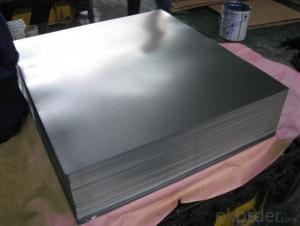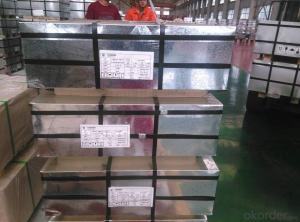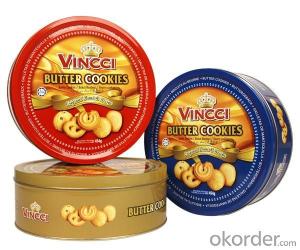Tinplate Sheets For Tomato Paste Can, Double Reduced
- Loading Port:
- China main port
- Payment Terms:
- TT OR LC
- Min Order Qty:
- 25000 m.t.
- Supply Capability:
- 40000 m.t./month
OKorder Service Pledge
OKorder Financial Service
You Might Also Like
Item specifice
1. Brief Introduction about our company
Our company is one largest state owned company and one largest tinplate supplier in China. Our annual output reaches more than 500,000 tons, both BA & CA, SR&DR. Now we have more than 10 overseas warehouses in the world, such as UAE, Saudi Arabia etc.
2. Specification
standard: GB/T2520, JIS G3303, DIN EN10202
Material: MR /SPCC
Thickness available: 0.16-0.50MM
Width available: 600~1050MM
Temper grade: T1 – DR8
Tin coating: ordinary 2.8g/2.8g, 5.6g/5.6g and others
Package: sea worthy export package.
Applications: Tin can for chemicals & paint cans, industrial cans, food cans
3. Our factory photo & equipments

4. Our Markets:
now our tinplate has been sold to more than 50 countries, including Europe country, Gulf Area, South American, South Afric etc.
5. FAQ
a. what’s your company name?
our company named CNBM international corporation, we are both one large state owned company and tinplate supplier in China
b. where your mill situated?
Our head office is in Beijing, while our mill in Hebei province.
c. how about the delivery time?
usually 55~65 days after receipt advance payment or original LC;
d. what payment term you accept?
Our payment term is very feasible, such as TT, DP, LC at sight, LC after sight etc.
e. can you offer MTC?
Of course, we will issue MTC after each shipment, for customer reference and testing if some quality issue appears.
- Q:How does tinplate impact the ease of opening and closing packaging?
- Tinplate, due to its durability and flexibility, positively impacts the ease of opening and closing packaging. It provides a sturdy and secure enclosure, ensuring that the package remains intact during transportation and storage. Additionally, tinplate's smooth surface allows for effortless opening and closing, making it convenient for consumers to access the contents of the packaging.
- Q:What are the main applications of tinplate in the aerospace industry?
- Tinplate is commonly used in the aerospace industry for various applications such as manufacturing fuel tanks, hydraulic systems, and electrical components. It provides excellent corrosion resistance, durability, and conductivity, making it ideal for these critical applications. Additionally, tinplate is lightweight, which is essential in aerospace to reduce overall weight and enhance fuel efficiency.
- Q:Can tinplate be recycled with other metals?
- Yes, tinplate can be recycled with other metals. Tinplate is typically made from steel coated with a thin layer of tin, and both steel and tin can be recycled. When tinplate is recycled, it is usually separated from other materials and processed separately to recover the steel and tin content.
- Q:How long does tinplate last?
- Tinplate can last for several decades, or even longer, depending on various factors such as the quality of the tin coating, the environment it is exposed to, and the maintenance practices followed.
- Q:How is tinplate coated for pharmaceutical packaging?
- Tinplate is commonly coated for pharmaceutical packaging through a process called electrolytic tin coating.
- Q:How does tinplate compare to glass in terms of packaging applications?
- Tinplate and glass have distinct advantages and disadvantages for packaging applications. Tinplate offers superior durability, resistance to corrosion, and can be easily formed into various shapes and sizes, making it suitable for canned food, beverages, and aerosol packaging. On the other hand, glass provides an elegant appearance, is chemically inert, and preserves the taste and quality of its contents. However, glass is fragile, heavier, and more expensive to produce and transport than tinplate. Therefore, the choice between tinplate and glass for packaging applications depends on factors such as product compatibility, cost, and customer preferences.
- Q:How does tinplate contribute to the shelf life of beverages?
- Tinplate contributes to the shelf life of beverages by providing a protective barrier that prevents contact between the beverage and its container. This barrier helps to prevent oxidation, contamination, and the transfer of flavors, ensuring the beverage stays fresh and retains its quality for a longer period of time. Additionally, tinplate containers are resistant to corrosion, maintaining the integrity of the packaging and further extending the shelf life of the beverages.
- Q:What are the main uses of tinplate?
- Tinplate is primarily used in the packaging industry for food and beverage containers, such as cans for canned foods, beverages, and aerosol products. It provides a protective coating to prevent corrosion and maintains the quality and freshness of the products. Additionally, tinplate finds applications in the manufacturing of various household items, decorative products, and electronic components.
- Q:How is tinplate coated with epoxy resin?
- Tinplate is typically coated with epoxy resin through a process known as electrostatic spraying or electrodeposition. In this process, the tinplate is first cleaned and pre-treated to ensure proper adhesion. Then, a positively charged tinplate is immersed in an epoxy resin bath containing negatively charged epoxy particles. The resin particles are attracted to the tinplate surface and adhere electrostatically, forming a uniform coating. The coated tinplate is then cured at high temperatures to harden the epoxy resin, resulting in a durable and corrosion-resistant finish.
- Q:What industries use tinplate packaging?
- The industries that commonly use tinplate packaging include food and beverage, cosmetics, pharmaceuticals, and household products.
1. Manufacturer Overview |
|
|---|---|
| Location | |
| Year Established | |
| Annual Output Value | |
| Main Markets | |
| Company Certifications | |
2. Manufacturer Certificates |
|
|---|---|
| a) Certification Name | |
| Range | |
| Reference | |
| Validity Period | |
3. Manufacturer Capability |
|
|---|---|
| a)Trade Capacity | |
| Nearest Port | |
| Export Percentage | |
| No.of Employees in Trade Department | |
| Language Spoken: | |
| b)Factory Information | |
| Factory Size: | |
| No. of Production Lines | |
| Contract Manufacturing | |
| Product Price Range | |
Send your message to us
Tinplate Sheets For Tomato Paste Can, Double Reduced
- Loading Port:
- China main port
- Payment Terms:
- TT OR LC
- Min Order Qty:
- 25000 m.t.
- Supply Capability:
- 40000 m.t./month
OKorder Service Pledge
OKorder Financial Service
Similar products
New products
Hot products
Hot Searches
Related keywords




























